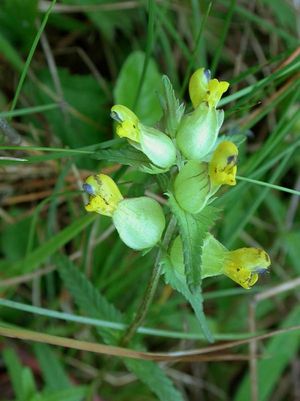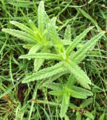Rhinanthus minor
- Scientific Name: Rhinanthus minor ssp. groenlandicus
- Family: Orobanchaceae
- Common Names: little yellow-rattle, arctic rattlebox
- Synonyms/Misapplications: Alectoropholus minor, Rhinanthus crista-gallii, R. articus, R. borealis, R. groenlandicus, R. minor ssp. borealis
- Codon: RHIMIN
Contents
Taxonomy
| Rhinanthis minor | |
|---|---|
| Scientific classification | |
| Kingdom: | Plantae |
| Subkingdom: | Tracheobionta |
| Phylum: | Spermatophyta |
| Subphylum: | Magnoliophyta |
| Class: | Magnoliopsida |
| Subclass: | Asteranae |
| Order: | Lamiales |
| Family: | Orobanchaceae |
| Genus: | Rhinanthus L. |
| Species: | Rhinanthus minor L. |
| Subspecies: | Rhinanthus minor ssp. groenlandicus (Chabert) Neuman |
Description
Erect hemiparasitic native perennial with opposite, wholly cauline, sessile leaves.
Flowers in terminal, leafy-bracteate spikes. Generally glabrous or thinly puberulent on 2 of 4 sides of squarish stem.
Leaves opposite, sessile, and cauline, scabrous and stiff, linear-lanceolate to ovate-lanceolate, toothed, 2-6cm x 4-15mm.
Calyx laterally flattened but somewhat inflated, corolla yellow, bilabiate, galeate, the upper lip hooded and enclosing the anthers.
Fruit is a flattened, orbicular, loculicidal capsule.
Differentiated from Rhinanthis minor ssp. minor by the bluish-gray teeth on the corolla upper lip, R. minor ssp. minor has whitish teeth and is less common.[1]
Bloom Period
June-August
Distribution
Boreal north America, Greenland, Eurasia, south to Washington and NW Oregon.[1]
Habitat
Mesic to moist meadows, fields, pastures, roadsides and clearings in lowland, steppe and montane zones, up to about 2,000 feet elevation.[2]
Photo Gallery
References
- ↑ 1.0 1.1 Hitchcock, C. L., Cronquist, A., Giblin, D., & Legler, B. et al. (2018). Flora of the Pacific Northwest: an illustrated manual. Seattle: University of Washington Press.
- ↑ Klinkenberg, Brian. (Editor) 2020. E-Flora BC: Electronic Atlas of the Plants of British Columbia [eflora.bc.ca]. Lab for Advanced Spatial Analysis, Department of Geography, University of British Columbia, Vancouver. [Accessed: 2020-05-09]




